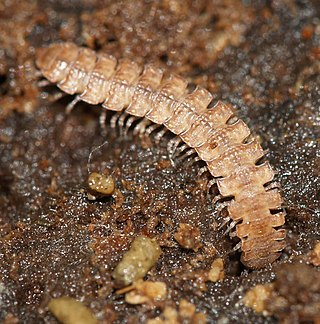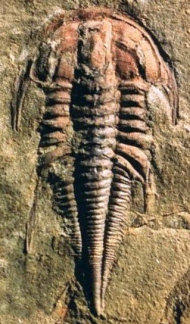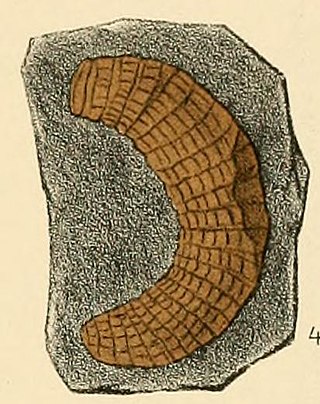
Millipedes are a group of arthropods that are characterised by having two pairs of jointed legs on most body segments; they are known scientifically as the class Diplopoda, the name derived from this feature. Each double-legged segment is a result of two single segments fused together. Most millipedes have very elongated cylindrical or flattened bodies with more than 20 segments, while pill millipedes are shorter and can roll into a tight ball. Although the name "millipede" derives from Latin for "thousand feet", no species was known to have 1,000 or more until the discovery in 2020 of Eumillipes persephone, which can have over 1,300 legs. There are approximately 12,000 named species classified into 16 orders and around 140 families, making Diplopoda the largest class of myriapods, an arthropod group which also includes centipedes and other multi-legged creatures.

Chilognatha is a subclass of the class Diplopoda, which includes the vast majority of extant millipedes, about 12,000 species.

Arthropleuridea is an extinct subclass of myriapod arthropods that flourished during the Carboniferous period, having first arose during the Silurian, and perishing in the Early Permian. Members are characterized by possessing diplosegement paranotal tergal lobes separated from the body axis by a suture, and by sclerotized plates buttressing the leg insertions. Despite their unique features, recent phylogenetic research suggests Arthropleuridea be included among millipedes in the class Diplopoda. The subclass contains three recognized orders, each with a single genus.

Emuellidae are a small family of trilobites, a group of extinct marine arthropods, that lived during the late Lower Cambrian of the East Gondwana supercontinent, in what are today South-Australia and Antarctica.

Pill millipedes are any members of two living orders of millipedes, often grouped together into a single superorder, Oniscomorpha. The name Oniscomorpha refers to the millipedes' resemblance to certain woodlice (Oniscidea), also called pillbugs or "roly-polies". However, millipedes and woodlice are not closely related ; rather, this is a case of convergent evolution.

Spirostreptida is an order of long, cylindrical millipedes. There are approximately 1000 described species, making Spirostreptida the third largest order of millipedes after Polydesmida and Chordeumatida.

The Eugeneodontida, sometimes also called Eugeneodontiformes, is an extinct and poorly known order of cartilaginous fishes. They possessed "tooth-whorls" on the symphysis of either the lower or both jaws and pectoral fins supported by long radials. They probably lacked pelvic fins and anal fins. The palatoquadrate was either fused to the skull or reduced. Now determined to be within the Holocephali, their closest living relatives are ratfish. The eugeneodonts are named after paleontologist Eugene S. Richardson, Jr. The Eugeneodontida disappeared in the Early Triassic. The geologically youngest fossils of the group are known from the Sulphur Mountain Formation, Vardebukta Formation and Wordie Creek Formation (Greenland).

Microderoceras is a flat sided, evolute, radially ribbed Lower Jurassic ammonite belonging to the ammonitid family Eoderoceratidae and superfamily Eoderoceratoidea. Its whorls are subquadrangular in section; venter on the outer rim, rounded; sides with two rows if distinct spines, tubercles on internal molds, formed at either end of the ribs. The lateral surface of the ribcage is concave toward both sides, the lateral side of the dorsal and the lateral side of the ventral surface. The ribs are divided into six pairs (1-3) of the following types: 2-3 is the only type. In the first type, the ribs on the ventral face are fused to the ribs on the ventral sides; the ribs on the dorsal face are fused to the ribs on the dorsal sides. The second type represents the ribbed body, the ribs are in the same arrangement as in the first type and the rib cage does not fuse to the dorsal surface.

Reticulosa is an extinct order of sea sponges in the class Hexactinellida and the subclass Amphidiscophora. Reticulosans were diverse in shape and size, similar to their modern relatives, the amphidiscosidans. Some were smooth and attached to a surface at a flat point, others were polyhedral or ornamented with nodes, many were covered in bristles, and a few were even suspended above the seabed by a rope-like anchor of braided glass spicules.

Archipolypoda is an extinct group of millipedes known from fossils in Europe and North America and containing the earliest known land animals. The Archipolypoda was erected by Scudder (1882) but redefined in 2005 with the description of several new species from Scotland. Distinguishing characteristics include relatively large eyes with densely packed ocelli, and modified leg pairs on the 8th body ring. Some species had prominent spines while others had a flattened appearance.

Richard Lawrence Hoffman was an American zoologist known as an international expert on millipedes, and a leading authority on the natural history of Virginia and the Appalachian Mountains. He was a biology professor at Virginia's Radford College for almost thirty years, and curator of invertebrates at the Virginia Museum of Natural History for another twenty years. He co-founded the Virginia Natural History Society, described over 400 species of millipedes, and produced more than 480 scientific publications. He is commemorated in the scientific and/or common names of over 30 animal species, including the valley and ridge salamander and Hoffman's dwarf centipede.

Brachydeiridae is a family of small to moderately large-sized arthrodire placoderms from the Late Devonian of Europe, restricted primarily to the Kellwasserkalk Fauna of Bad Wildungen and Adorf.

Tylobolus is a genus of millipedes in the order Spirobolida with seven known species found in western North America. It is in the family Spirobolidae, and is the type genus of the subfamily Tylobolinae. The genus was named by Orator F. Cook in 1904.
Floridobolus is a genus of millipedes commonly known as Florida scrub millipedes containing three described species: Floridobolus penneri, F. orini, and F. floydi; the latter two described in 2014. All three species are endemic to Florida scrub habitat of peninsular Florida, and F. penneri is considered a critically imperiled species by NatureServe. Prior to the description of F. orini, the genus was considered the sole member of the family Floridobolidae, named by William T. Keeton in 1959, however studies in 2014 have argued that Floridobolus does not represent a distinct family but rather is a basal member of the family Spirobolidae, representing the subfamily Floridobolinae, and tribe Floridobolini.
Aprosphylosoma darceneae is a species of cylindrical julidan millipede found only in the U.S. state of Oregon and comprising the sole species of the family Aprosphylosomatidae. It is known from only a single known specimen collected from Oregon Caves National Monument in 1956 that measures approximately 16 mm (0.63 in) long and 1 mm wide, possessing 59 body segments. The first pair of legs are extremely reduced into non-jointed, peg-like structures. The body color is yellowish brown with darker brown mottling on the dorsal surface, and the legs are white.
The Campbellton Formation is a geologic formation in New Brunswick. It preserves fossils dating back to the latest Pragian and Emsian of the Devonian period.

Archidesmus is an extinct millipede genus from the Lower Devonian Old Red Sandstone of the United Kingdom. It is the only member of the taxonomic family Archidesmidae. Individuals were up to 5 cm (2.0 in) long, and had 60 to 80 body segments decorated with tubercles (bumps) on the upper surface, and most segments possessed wing-like keels (paranota) extending to the side. The type species Archidesmus macnicoli was described by British paleontologist Benjamin Peach in 1882. A second species, A. loganensis was also described by Peach but its status as a valid species- or even a myriapod- is debated.
Palaeodesmus tuberculata is an extinct species of millipede known from the lower Devonian period of modern-day Scotland. It was originally described as "Kampecaris tuberculata" by the Reverend Stanley Graham Brade-Birks, but was placed in its own new genus, Palaeodesmus, in 2004. Palaeodesmus has three rows of tubercles or bosses in the shape of round-edged squares or rectangles on the dorsal portion of each body segment. Palaeodesmus is a member of the extinct group Archipolypoda, but its anatomy is too poorly known to place it confidently within any known taxonomic family or order, and so it remains incertae sedis, although possibly related to archidesmidan species such as Archidesmus.

Juliformia is a taxonomic superorder of millipedes containing three living orders: Julida, Spirobolida, and Spirostreptida, and the extinct group Xyloiuloidea known only from fossils.

Nyranius is a genus of fossil millipedes from the Upper Carboniferous (Westphalian) of Europe, containing the species N. costulatus and N. tabulatus. Specimens reach up to 10mm in width, and are covered in fine grooves, similar to other members of the extinct Xyloiuloidea.
















